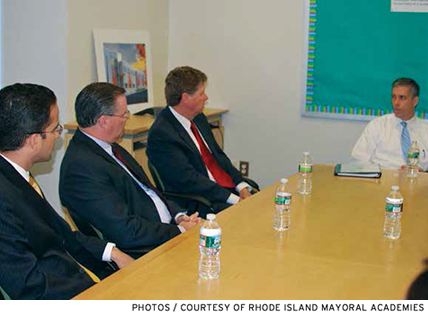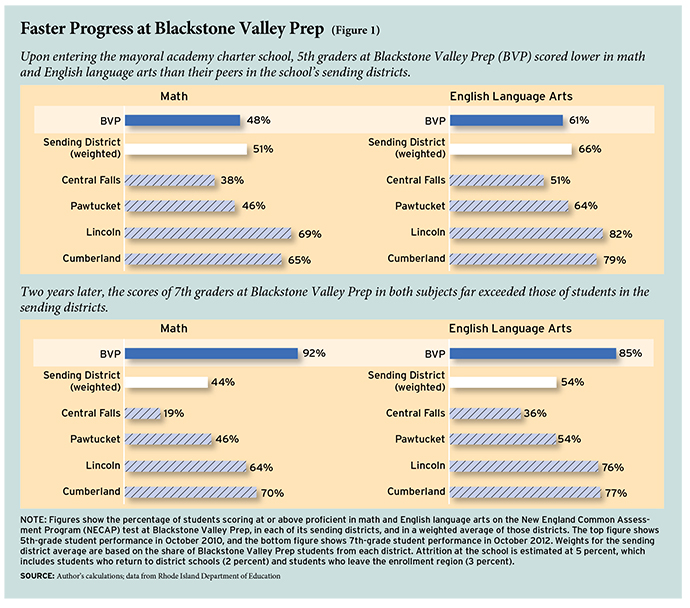In 2007, the case could be made that Rhode Island had, dollar for dollar, the worst-performing public education system in the United States. Despite per-pupil expenditures ranking in the top 10 nationally, the state’s 8th graders fared no better than 40th in reading and 33rd in math on the National Assessment of Educational Progress (NAEP). Only three other states ranked above the national average in dollars spent but below the national average in student outcomes. Rhode Island’s Latino 8th graders, the state’s largest and most rapidly growing minority population, were the lowest-performing in the nation, and the achievement gap between Latino and white students in the state was among the nation’s largest.

The state’s education troubles were hardly limited to urban districts like Providence, Central Falls, Newport, and West Warwick, all of which had per-pupil expenditures well above the state average. Closing the math proficiency gap between poor and nonpoor students at suburban Cumberland High School, for example, would have required raising the share of low-income students who were proficient from 16 percent to 44 percent. And because of low performance among white students in urban districts, a focus on closing school-level achievement gaps was clearly insufficient: closing the racial achievement gap at Central High School in Providence in 2007 would have entailed raising the proficiency rate of African American students from 7 percent to where white students were, at 9 percent. As a motivating goal, it was modest to the point of incoherence.
In the spring of that year, Cumberland mayor Daniel J. McKee posed a question: “What kind of public school system would we have if we could just build it from scratch?” At the time, I had recently been recruited to serve as director of Cumberland’s Office of Children, Youth, and Learning. He and I were sitting in his office on Cumberland’s Broad Street, overlooking the Blackstone River. Broad Street extended south through the cities of Central Falls and Pawtucket. One mile down the road was a public school that had been operating continuously since the mid-19th century. Out the mayor’s third-story window was a view of the birthplace of the American Industrial Revolution.
The answer to the mayor’s question turned out to be “mayoral academies,” highly autonomous, socioeconomically diverse, regional public schools of choice governed by mayor-led boards. The law permitting mayoral academy charter schools freed the schools from Rhode Island’s tenure, prevailing wage, and pension laws. It also required the schools to enroll students from both urban and nonurban districts in order to encourage demographic diversity. A mayor from one of the enrollment districts must chair the board of the school, while other board members represent the other enrolling communities.
The Schools
Rhode Island’s basic profile had changed little by the time U.S. Secretary of Education Arne Duncan told a crowd of Rhode Island stakeholders in late 2011, “In math, Rhode Island’s white students trail Iceland, Estonia, Slovenia. In reading, Rhode Island’s white students trail Australia, Canada, and Belgium…Rhode Island’s white students trail their counterparts in 37 states in math, and in reading, white students here trail their counterparts in 33 states.” But thousands of Rhode Island students were gaining new and far better choices for where to attend school.
Blackstone Valley Prep (BVP) was the first mayoral academy charter school to open its doors. Some 1,000 students attend three schools: a K–4 elementary school and grade 5–8 middle school are both fully enrolled, and a growing second elementary school currently serves grades K–2. The three facilities are within two miles of each other on the urban-suburban border of their enrolling communities. BVP’s charter was recently renewed, and under its renewal plan it will grow to approximately 2,400 students in seven schools spanning kindergarten through high school. Mayor McKee currently chairs the board.
The first BVP elementary and middle schools are among a small number (less than 10 percent) of public schools to receive the highest “Commended” designation from Rhode Island’s commissioner of education. This past year, 92 percent of BVP’s 7th graders (at the time the highest grade level enrolled) were proficient in math, a figure that topped every middle school in the state but one, a small suburban charter school (see Figure 1). Approximately two-thirds of its students are low-income. Half are black or Latino. More than one-third are middle-class white students who would otherwise be attending their suburban neighborhood public school.

The demographic composition of the school is part of a purposeful outreach and enrollment strategy endorsed by the mayors. BVP is among a growing number of high-performing charter-school networks (including Summit Public Schools, Citizens of the World Charter Schools, Denver School of Science and Technology, and others) that are intentionally socioeconomically diverse.
Achievement First Providence Mayoral Academy (AFPMA) opened in August 2013 with 176 students in a former district school building. Like BVP, AFPMA serves a demographically diverse region, enrolling from the districts of Cranston, North Providence, Providence, and Warwick. A registration partnership with the Providence public school district led to extraordinary demand from Providence residents (half of Providence kindergartners registered for a seat at AFPMA). Consequently, AFPMA’s first cohort of students is less demographically diverse than BVP’s. Approximately 80 percent of students are from low-income families. Providence mayor Angel Taveras chairs the board.
Launching RIMA
Among the challenges to building support for a new type of charter school in Rhode Island were the traditional message of the education reform movement and its unwavering focus on urban schools. An enrollment model like the one Mayor McKee and I envisioned would challenge the conventional wisdom that the state’s educational troubles were limited to its urban centers. Perhaps new schools of choice could strategically ignore the old boundaries. Mayor McKee in particular believes that racially and economically diverse student bodies benefit all involved. As an AAU basketball coach, he’d seen the reciprocal benefits of diversity firsthand. Ideally, we would enroll “the entire RI student demographic in one regional system,” he said.

Mayor McKee in 2008 contracted with education consulting firm Public Impact to analyze student achievement and education spending in Rhode Island, and in the Blackstone Valley region in particular, and to assess the potential impact of mayoral academies for urban ring communities. The report, “Boosting Performance and Containing Cost through Mayoral Academies,” contrasts the low performance of low-income and minority students and the wide achievement gaps in traditional district schools, and the high performance of low-income and minority students and smaller achievement gaps in high-performing charter schools in neighboring states. The report also notes, however, that “even in the schools deemed ‘suburban’ by the state department of education, large percentages of students were not mastering state standards in the most recent testing year.” The authors recommended that “Mayoral Academies should be required…to construct their lotteries in order to achieve a mix of distressed urban and other students.” With that report in hand, Mayor McKee and a group of like-minded municipal leaders went about attempting to change Rhode Island’s charter-school law.
In 2008, Rhode Island had perhaps the most restrictive charter school law in the nation. A single authorizer, the state department of education, could approve two types of charter schools: 1) in-district charter schools that enjoyed some programmatic flexibility but existed fully under the district’s collective bargaining agreement with teachers, and 2) “independent” charter schools that were outside of district collective bargaining agreements but were nevertheless subject to the state’s tenure law, its prevailing wage statutes, and its teacher retirement system. Wanting to innovate and to attract outstanding school operators to Rhode Island from neighboring states, McKee and his peers sought broad exemptions from these restrictions. Leaders of numerous high-performing charter schools across the Northeast had explicitly told them that such exemptions were a prerequisite to pursuing expansion to Rhode Island. Advisors in the state department of education, the governor’s office, and the General Assembly had suggested that while a complete overhaul of the charter school law would be politically impossible, a “carve-out” within the charter school law to allow for a new, more autonomous type of charter school might be achievable.
It soon became clear that if mayoral academies were to become a viable public school model, one organization would need to function as “harbormaster,” committed to making the sector as hospitable as possible for the opening of new, high-quality public schools, and easily identifiable as the one to go to for answers and assistance. In February 2009, Rhode Island Mayoral Academies (RIMA) was incorporated to fill that role. Over the last five years, RIMA has marshaled local and national philanthropy; recruited school operators and educators into Rhode Island; provided staff support for facilities identification, finance, and development; formed and advocated for improved education policies at both the state and local levels; and served as a “help center” for questions about state laws, regulations, practices, and culture.
RIMA’s facilities-support operations continue to be a point of emphasis and a challenge. We began by raising our own equity and developing a facility for BVP, which RIMA continues to own. More recently, we worked with fellow members of the Central Falls District Charter Compact to secure a $10 million program-related investment (PRI) loan from the Bill & Melinda Gates Foundation to support facilities development in partnership with the nonprofit charter-school facilities developer Civic Builders. RIMA has also helped to negotiate leases of district-owned facilities. Lastly, we continue to advocate for equitable distribution of state facilities aid for all public schools.
From the outset, RIMA envisioned a governance structure that would give mayors a meaningful leadership and oversight role while providing school operators with a high level of autonomy to implement and run their programs. From the standpoint of public accountability, mayors were the smart point of contact, those most naturally inclined to see the value of autonomy, flexibility, and choice; most likely to embrace an outcomes-based approach to governance; and most effective at articulating the value of education to overall community well-being. Involving mayors in governance would have the collateral benefit of greater political buy-in, access, and influence at both the municipal and state levels. In the bargain, RIMA and its school operator partners would have to take the perspective and opinions of a large group of municipal leaders into account and accept the consequences (both positive and negative) of a more central role in the public conversation about education.
Rhode Island’s charter-school law allows multiple schools and an unlimited number of students to be governed by a single charter and a single school board. The first mayoral academy charter, granted in 2009, permitted RIMA to launch five schools serving more than 2,000 students in four communities, two of them urban (in Central Falls and Pawtucket) and two suburban (in Cumberland and Lincoln). The plan called for a New York–based charter management organization (CMO) to provide management services to the mayoral academy board.
The governance structure of this fledgling network reflected RIMA’s desire to tightly monitor what would be a brand-new kind of charter school. RIMA maintained the authority to appoint all board members. We were navigating complex relationships between three entities that wanted significant influence over governance of the schools: the mayors, RIMA, and the CMO. Over time, we established a balance of power that is sensible and sustainable. RIMA appoints approximately one-quarter of the mayoral academy board and works with the involved mayors and CMO or executive director to develop the rest of the board to everyone’s satisfaction.
Political Backstory
As with all major legislative accomplishments, getting from idea to reality takes time and the sustained efforts of committed individuals at every level of government and throughout the communities that stand to gain from a successful campaign. The battle for mayoral academies was no exception.

Early in 2007, Mayor McKee had created a new municipal department, the Office of Children, Youth, and Learning (OCYL). Distinct from his school department (which, like more than 90 percent of Rhode Island’s school districts, is governed by an elected school committee), OCYL’s mission was to extend learning time for as many Cumberland children and youth as possible while raising the community’s expectations regarding educational outcomes. OCYL was McKee’s first foray into reform. The office continues to provide valuable services to families while helping the community become acclimated to his increased involvement in public education.
Mayor McKee had also aligned himself with a bipartisan coalition of municipal leaders who together represent about two-thirds of Rhode Island’s population. The majority of these leaders serve in Rhode Island’s “urban ring” communities, with populations of between 20,000 and 100,000 residents and student poverty rates between 25 percent and 50 percent. They have practical experience with the ways in which “governance constitutes a structural barrier to academic and management improvement…where turf battles and political squabbles involving school leaders and an array of stakeholders have for too long taken energy and focus away from the core mission of education,” as researchers Kenneth K. Wong and Francis X. Shen describe in a 2013 study extolling the value of mayoral leadership in education reform.
The mayors, a group that here also includes elected town administrators, view their offices as the locus of accountability, particularly for the efficient and effective use of tax dollars. They discuss a wide range of issues, including public safety, health, finance, environmental management, housing, economic development, and education, and prospects for regionalization. There are clearly fiscal and management efficiencies to be found in a state of only 1 million people that, nevertheless, has 39 municipalities, 36 school districts, and 78 fire departments. But the mayors were skeptical about both the prospects for and advisability of taking direct control over their school systems and were looking for other, more innovative ways to intervene to improve schools. They are also aware of “the powerful role that real estate values play in determining access to this public good [the school], and raising (or lowering) its market value,” as Trinity College professor Jack Dougherty has written. “Although we call them ‘public’ schools,” Dougherty notes, “we buy and sell access to most as ‘private’ commodities, based on the underlying real estate and governmental boundary lines that restrict entry.” This economic fact made any regionalization of district systems (or even redistricting of individual systems) bureaucratically difficult and politically hazardous.
Yet the urban ring mayors saw in their school district systems the same structural flaws that the urban mayors saw in theirs. The length of day, the hiring and compensation procedures, the employee training programs, and the curricula are substantially similar across all traditional district systems, from the 2,000-student system with a 10 percent poverty rate to the 25,000-student district with an 80 percent poverty rate. They also had firsthand knowledge of the links between education, economic development, and community resilience. Though they had it in hand, they didn’t need data to see the impact of, for example, low graduation rates on the health of their communities. In 2007, the connection between academic success and economic resilience was about to take on greater urgency as Rhode Island’s unemployment rate began to climb from 4.9 percent to a second-in-the-nation 12.7 percent in December 2009.
Nevertheless, the mayors faced significant opposition in proposing the mayoral academy legislation. The state affiliates of the National Education Association, American Federation of Teachers, and AFL-CIO testified and lobbied aggressively against it. The Rhode Island League of Charter Schools, concerned that the law would create a “two-tiered” charter school system, but lacking consensus among its members as to whether to propose similar autonomy for all charter schools, initially opposed the legislation as well, withdrawing that opposition late in the legislative session. The state department of education itself provided ambivalent testimony.
In late June 2008, on a close 41–30 vote to defeat a budget amendment on the House floor, the bill to create mayoral academies cleared its final meaningful hurdle. Testimony in opposition to the bill was lengthy and theatrical. However, there was also compelling support from a diverse group of representatives. In an extraordinary closing speech, Majority Leader Gordon Fox (who would go on to become Speaker) applauded the mayors’ political courage:
It’s about time that we stand up and be counted. We’re responsible for the barriers…I applaud Mayor McKee and all the mayors that have come out on this. I applaud everyone that’s brave enough to break the status quo…so that Johnny and Jane can compete with not [just] a kid from New York or California but with a kid from Tokyo or Berlin…Vote yes to our children’s future and let’s give the mayoral academies, with the chief executive officers, the people that run our cities and towns, the opportunity to put a plan together with the best and brightest minds in this world, all for the betterment of Rhode Island.
The decision to engage a wide range of municipal leaders paid off in the letters and opinion pieces those leaders wrote and the individual outreach they did to their local representatives in support of the bill. The final bill reflected their vision for the new brand of charter schools they wanted to see.
A few months later, having secured start-up funding from a group of local philanthropists, I left the OCYL to lead the newly founded RIMA. Also in 2009, by a margin of 47–26, the House appropriated the funding necessary to open the first mayoral academy. In addition to many of the mayors who had supported the mayoral academy concept from the beginning, Governor Donald Carcieri, Commissioner Deborah Gist, and Speaker Fox attended and spoke at the ribbon-cutting ceremony for the first mayoral academy in October 2009.
Then, in 2010, the mayors who were engaged in RIMA’s efforts commissioned a report from Public Impact and Harvard University education professor Martin West that recommended major changes to Rhode Island’s education funding policy, enabling the “money to follow the student” to the school of his choice. Titled “Fund the Student: A Plan to Fix Rhode Island’s Broken Public School Finance System,” the report was signed by a bipartisan group of 13 mayors, and directly influenced the passage of a new state law creating a more equitable weighted student funding system in Rhode Island. Importantly for RIMA, the new funding formula made the creation of new public schools, including mayoral academies, budget-neutral for the state, eliminating a strong disincentive to charter school growth.
The Mayor Model Works
The challenge of innovating and implementing simultaneously led to some bumps in the road: in late 2010, the BVP board ended its contractual relationship with its CMO after lengthy negotiations failed to resolve disagreements over governance authority, reporting, and management fees. RIMA supported the transition plan. Thanks to strong leadership at the school and the continued commitment and focus of the board, outcomes at BVP have remained consistently excellent.

Over the course of the application process for the second network of mayoral academies, we saw a downside of having a charter growth effort identified with mayors. The application was swept up into a larger political struggle between the Republican mayor of Cranston, Allan Fung, and Cranston’s Democrat-controlled school committee. The fault was ours. We had not fully understood the political environment in which we were operating and learned a hard lesson. A veteran, well-liked superintendent and politically influential school committee chair were forcefully opposed to the application, and willing and able to organize teachers and principals to testify at public hearings. By sheer coincidence, “Occupy Providence,” the local arm of the Occupy Wall Street movement, had begun during the application process. Occupy Providence seamlessly folded a message about our “corporate” or “big box” charter-school application into their talking points, giving additional force to the opposition’s testimony.
The mayors were steadfast throughout: at one point, several of them held a press conference outside the governor’s office door—attended by every news outlet in the state—to press for approval. The fight to get Achievement First Providence Mayoral Academy approved took more than a year and involved, in one way or another, every political leader in Rhode Island. Approval finally came in February 2012.
The participation of mayors in the governance of mayoral academies has been wholly positive. Regionalization, a chief concern of the mayors, ironically presented a way to address what those on the policy side had dubbed “the bad-mayor scenario.” Desiring mayoral involvement was fine, but if one mandates it in state law, what happens when you get a mayor of questionable competence, or who is aligned with public education’s entrenched status quo, or who decides to influence or control a school’s hiring practices, or who simply doesn’t want to be involved? What happens if the “good mayor” you start with loses an election to a “bad mayor” you’re stuck with?
The governance structure we devised and the reach of the schools across municipalities provide a solution. Depending on the enrollment area, a mayoral academy board might have between two and six mayors to choose from to serve as board chair. Over the last five years, five mayors have served on the BVP board. Even when one, Charles Moreau of Central Falls, was indicted (on charges unrelated to BVP), his resignation from the board was managed uneventfully.
Nor has involvement in mayoral academies been a political liability for the mayors. Since 2008, the half dozen or so mayors most prominently engaged in RIMA’s efforts have either won reelection handily or run unopposed. A number of them have sought to transfer lessons learned from the mayoral academies to their district schools with some early success.
For its part, RIMA intends to continue expanding statewide by supporting mayors and outstanding educators as they work together to “build schools from scratch.”
Michael Magee is co-founder and chief executive officer of Rhode Island Mayoral Academies.
This article appeared in the Winter 2014 issue of Education Next. Suggested citation format:
Magee, M. (2014). The Mayors’ Charter Schools: Innovation facilitates socioeconomic integration and high performance. Education Next, 14(1), 22-28.


